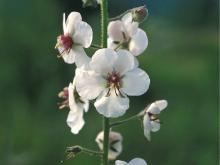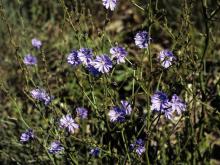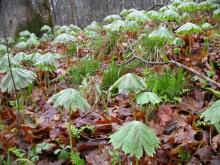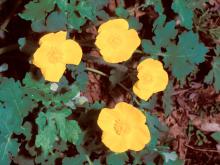Wildflowers, Grasses and Other Nonwoody Plants
Media

Species Types
Scientific Name
Viola pubescens (formerly V. pensylvanica)
Description
The yellow violet is Missouri's only all-yellow violet. This native wildflower is less common than violet violets. Look for it in low woods, rich slopes, and wooded floodplains.
Media

Species Types
Scientific Name
Collinsia verna
Description
The flowers of blue-eyed Mary are only about a half inch wide, but this pretty wildflower makes up for it by usually appearing in abundance, covering a patch of forest floor with little sky-blue and white “faces.”
Media

Species Types
Scientific Name
Torilis arvensis
Description
Hedge parsley is an introduced plant that looks a lot like parsley. It was first collected in Missouri in 1909 and has become much more abundant in recent decades as it spreads along roadsides and railroads.
Media

Species Types
Scientific Name
Erigenia bulbosa
Description
Heralding a new growing season, harbinger of spring can bloom as early as January in Missouri. You will probably have to look closely for its small clusters. But after a long winter, what a welcome sight they are!
Media

Species Types
Scientific Name
Verbascum blattaria
Description
Moth mullein is a native of Eurasia introduced to our continent in the early 1800s. Since then, it has spread across North America. It’s named because the fuzzy flower, with 2 antennalike stamens, looks something like a moth.
Media

Species Types
Scientific Name
Ageratina altissima (formerly Eupatorium rugosum)
Description
White snakeroot looks very similar to thoroughworts, but it has triangular leaf blades that are more broadly angled or rounded at the base. White snakeroot is common statewide. It’s a toxic plant if eaten, so it’s good to be able to identify it.
Media

Species Types
Scientific Name
Cichorium intybus
Description
In summer and fall, the pretty blue flowers of chicory decorate roadsides and other disturbed areas. This weedy member of the aster family was introduced from Europe long ago. Its roots have been used as a coffee substitute.
Media

Species Types
Scientific Name
Podophyllum peltatum
Description
Mayapple is a common spring wildflower that makes its biggest impression with its leaves, which resemble umbrellas arising from a single stalk. It often grows in colonies.
Media

Species Types
Scientific Name
Aureolaria pectinata (formerly Gerardia pedicularia)
Description
There are 3 species of Aureolaria in Missouri. Only combleaf yellow false foxglove is annual, has fernlike, delicately dissected leaves, and glandular hairs. It occurs in the Ozarks.
Media

Species Types
Scientific Name
Stylophorum diphyllum
Description
The showy, bright yellow flowers of celandine poppy really stand out in the shady woods and valleys where this plant grows. You should consider this species when you are planting a shade garden!
See Also
About Wildflowers, Grasses and Other Nonwoody Plants in Missouri
A very simple way of thinking about the green world is to divide the vascular plants into two groups: woody and nonwoody (or herbaceous). But this is an artificial division; many plant families include some species that are woody and some that are not. The diversity of nonwoody vascular plants is staggering! Think of all the ferns, grasses, sedges, lilies, peas, sunflowers, nightshades, milkweeds, mustards, mints, and mallows — weeds and wildflowers — and many more!





















